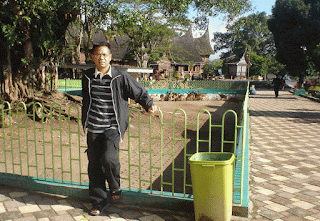In Minangkabau Cultural Center we could see home industries
such as ; blacksmith, silverworks, hand weaving and basketry. Also in
Minangkabau highland, we could to explore the beautiful town. Pagaruyung site
of the ancient Minangkabau Kingdom where Queen ruled in maternal society.The
people of Minangkabau used to leave their country and live at other areas of
Indonesia, even in Malaysia. If you see a restaurant named "Ruman Makan
Padang" it is a Minangkabau restaurant, and sometimes in short called
"Rumah Makan Minang". Many experts say that matrilineal system of
their society that force Minangkabau men to leave their land.Minangkabau people
speak Malay with some slights different, which can be grouped as dialect /a/
tends to use /a/ as the first vowel, and dialect /o/ tends to use /o/ as the
first vowel.
The original house
of Minangkabau is a high house, built on poles with roofs shaped as horn,
almost similar with that of Torajan in south Sulawesi. The house is called
"Rumah Gadang".Basic economic activities are farming, trade, and
small part also introduce handicraft such as weaving and silver works. Most of
the trades activities have been handled by Minangkabau people themselves, and
very few outsiders that can participate in this economic activities.Within the
Nagari organization system it is introduced 2 basic systems. Firstly is
Body-Caniago, a democratic system, and Koto-Piliang system, an autocratic
system. Today these 2 systems have become more and more disappeared due to the
application of national system.Almost all people of Minangkabau is Moslem. In
the past many rituals that had relation with religion now already discarded or
simply forgotten. Some people are still believe in invisible being or holy
spirits that could effect human life.
In Minangkabau, the
centralization of power is never in the hand of a family leader, but the
authority is usually vested in a Senior Woman (Mother or Grandmother) or a
mamak (the mother's brother -- Uncle-). In the Minangkabau kinship system, the
grandmother if she is still alive has a higher status than the mamak. Both men
and women are involved in traditional ceremonies. In the processing of
marriage, the role of women is very dominant. Generally, they have the right to
supervise the ricefield management and the harvest including the supervision of
the earnings, trading, sewing, etc.
Bukittinggi
Bukittinggi, 930 meters above sea level in the heart of
the Agam Highlands, is clean and pleasant town with a climate like that of a
southern European Summer. It is two hours drive away from Padang. The road
partly winds through the impressive mountain landscape of the Anai Gorge, which
is a nature reserve with dense tropical rainforest vegetation. Below it flows
the river Anai. Just a side the road, near the sport where the rail road tracks
disappear in a tunnel mounts in the cliff, is a 40 meters high waterfall.
An
unusual landmark inside Bukitinggi is the clock tower near the market.
Bukittinggi’s great attraction is it’s magnificent natural surroundings. At the
fringe of the city is the Ngarai Sianok a canyon with walls about 100 meters
high separating Bukittinggi from Koto Gadang, a village renowned for it’s
silver craft. The village could be reached by following a footpath cutting five
kilometers across the canyon, or by bus or car over the main road, which is a
12 kilometers distance. A stream meanders through green fields at the floor of
the canyon. Footpaths lead to little parks with lookouts.
Surrounded
by mountains, Bukittinggi is the usual point of departure for trips further
into the highlands. Also worth visiting are the museum, which is grand old
traditional house built in the past century and the zoo.
















